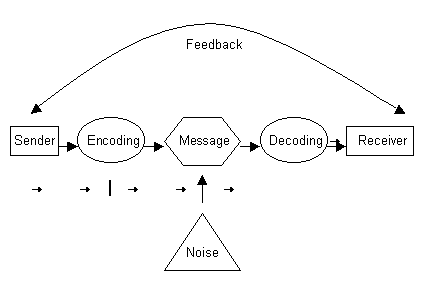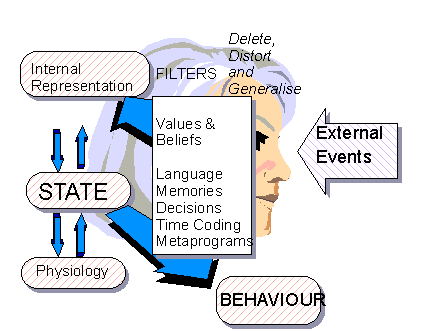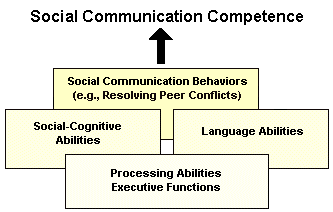Internal
Links
Top
|
|
Outline on the Communications
Process
|
|
External
Links
|
|
|
There are SEVEN components in the communications process that all interact
| 1. Sender |
6. Receiver |
| 2. Message |
7. Feedback Loop |
| 3. Encoding |
8. Communications Environment |
| 4. Medium |
9. Noise |
| 5. Decoding |
|
|
|
|
Link
|
The Figure on the Communications Process
shows
that communication is usually 2 way, & is a relatively fragile process |
|
|
|
1. THE SENDER IS AN INDIVIDUAL, GRP, OR ORG THAT NEEDS
TO COMMUNICATE |
|
|
|
The sender is the individual, group, or org that needs or wants to
share info w/ some other individual, group, or org in order to accomplish
one or more of the functions of communications |
|
| |
2. THE MESSAGE IS THE TRUE MEANING OF WHAT ONE WANTS
TO COMMUNICATE |
|
|
|
The message is the info the sender needs or wants to share w/ others |
|
|
|
Messages should be as clear & complete as possible to be effective |
|
|
|
A message is clear when in contains info that is easily interpreted
or understood |
|
|
|
A message is complete when it contains all the info necessary to achieve
a common understanding btwn the sender & receiver |
|
|
|
If a message is vague or one is unsure about what a message should
be, communications are likely to be ineffective |
|
| |
Commo in orgs should provide accurate info w/ the appropriate emotional
overtones to all members who need the communication system & that is
is clear who can utilize the info that is available |
|
| |
Providing accuracy, emotional overtones, & the appropriate target
audience is an impossible goal for commo in orgs |
|
| |
Feldman & March, 1981, claim that orgs gather more info than they
use, & they continue to ask for more |
|
| |
The control of more info creates more legitimacy |
|
| |
3. ENCODING OCCURS WHEN THE MESSAGE IF FORMED BY THE
SENDER & THE MEDIUM INTO SPOKEN, WRITTEN WORDS OR SOME OTHER FORM |
|
|
|
To send a message, the sender must engage in encoding |
|
|
|
Encoding is the translating of the message into symbols or language
that the receiver can understand |
|
|
|
Typically to encode, the senders need basic writing & oral communication
skills |
|
|
|
The sender must take care to use words the receiver understands |
|
|
|
Effective communication can be affected by the use of jargon |
|
|
|
Jargon is specialized terminology or language that members of a profession,
occupation, or other group develop to aid communications among themselves |
|
|
|
The use of specialized language & jargon facilitates communication
w/in an occupation or org because a single term can be used to describe
a complex idea |
|
|
|
But the use of specialized language & jargon usually leads to ineffective
communication when receivers are outside the occupation or profession |
|
|
|
4. THE MEDIUM OF COMMUNICATION IS OFTEN THE SPOKEN
OR WRITTEN WORD VIA PERSONAL COMMO, TV, RADIO, INTERNET, NEWSPAPERS, ETC. |
|
|
|
The encoded message is transmitted to the receiver through some medium |
|
|
|
The medium is the pathway through which an encoded message is transmitted
to a receiver |
|
|
|
Verbal communications is the sharing of info by the means of works,
either spoken or written |
|
|
|
Verbal communications can take the form of face- to face oral communications;
oral communications over the phone & written communication using memos,
letters, & reports that can be transmitted electronically |
|
| |
Each medium has advantages & disadvantage |
|
| |
Choose a medium the receiver monitors |
|
| |
People differ in the media they prefer; some prefer face to face communications
& others prefer seeing things in writing |
|
| |
The best way to get a message across is to use the medium the receiver
pays the closest attention to |
|
| |
Select a medium appropriate for the message |
|
| |
Some types of messages are best conveyed face to face |
|
| |
A complex message is best conveyed in written form so that the receiver
can refer back to it |
|
| |
Use multiple media when necessary |
|
| |
An important message should be given face to face & then followed
up w/ a memo |
|
| |
Nonverbal communication is the sharing of info by means of facial expressions,
body language, & even mode of dress |
|
| |
Nonverbal communication is used when people feel uncomfortable about
expressing part of a message verbally |
|
| |
People tend to have less control over their nonverbal communication
than over their verbal communication |
|
| |
It is difficult to conceal insincerity |
|
|
Link
|
Nonverbal communication is also a good medium for communicating support,
acceptance, and a sense of camaraderie |
|
| |
5. DECODING OCCURS WHEN THE MESSAGE IF FORMED BY THE
RECEIVER & THE MEDIUM INTO SPOKEN, WRITTEN WORDS OR SOME OTHER FORM |
|
| |
The words we hear, the images we see all have a meaning for the receiver
that may be different from that of the sender, based on such variables
as experience, context, nationality, etc. |
|
| |
Some messages that include a dialect, jargon, etc. are esp difficult
to decode & errors are more likely to occur |
|
| |
Leaders often can only speak in generalities & must avoid details
because of the difficulty of decoding; the audience does not have enough
knowledge or context to meaningfully decode a complex message |
|
| |
6. THE RECEIVER IS THE INDIVIDUAL, GROUP, OR ORG WHO RECEIVES
THE MESSAGES |
|
| |
The receiver may or may not be the intended receiver; i.e., some people
may receive the message who were not intended to receive the message, or
who do not need the message |
|
| |
Any receiver must decode the message |
|
| |
Decoding is interpreting or trying to make sense of a sender's message |
|
| |
Decoding is easy if the message is clear but difficult if the message
is ambiguous |
|
| |
When messages are ambiguous, they are subject to the receiver's interpretation
& are more likely to be influenced by the receiver's own beliefs, attitudes,
values, moods, perceptual biases, and so on |
|
| |
6. THE FEEDBACK LOOP INCLUDES THE INTENTIONAL &
UNINTENTIONAL MESSAGES THAT RECEIVER SENDS BACK TO THE SENDER UPON RECEIVING
THE MESSAGE |
|
| |
The feedback is the communication that the receiver sends back to the
sender indicating that they have received the message & demonstrating
their interpretation of the message |
|
| |
Once the message is decoded, the receiver has to respond to it, thereby
starting the feedback loop |
|
| |
A variety of types of feedback are available |
|
| |
One type of feedback is acknowledging the receipt of the message |
|
| |
One type of feedback is ignoring the receipt of the message |
|
| |
One type of feedback is responding to the message w/ the requested
info |
|
| |
One type of feedback is asking for clarification |
|
| |
During feedback, encodes their feedback, chooses the medium the original
sender monitors |
|
| |
During feedback the original sender decodes the response & determines
whether the receiver properly interpreted the initial message |
|
| |
If the sender believes the receiver did not properly interpret or decode
the original message, then the communication process usually continues
until both parties are confident they have reached a common understanding |
|
| |
7. THE COMMUNICATIONS ENVIRONMENT INCLUDES ANY FEATURES IN
THE ENV THAT AFFECT COMMUNICATIONS |
|
| |
The communications environment includes any features in the env that
affect communications |
|
| |
The env may enhance or degraded the communications process |
|
| |
Factors in the env that affect communications include everything from
physical noise, the competing messages, to irrelevant messages to social
factors such as language, dialect, beliefs, etc. |
|
| |
Part of the communications env includes the social relations in the
env |
|
|
Link
|
The social relations in the process involve & affect senders &
receivers & their reciprocal effects on each other as they are communication |
|
| |
8. NOISE INCLUDES MESSAGES OR OTHER EFFECTS WHICH CHANGE OR
ENHANCE THE MESSAGE |
|
| |
Noise often includes factors that degrade the communications process |
|
| |
Noise sometime may include factor that enhance the communications process
as when music is played to enhance, highlight, or otherwise improve verbal
commo |
|


